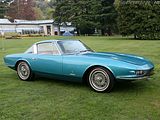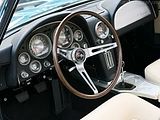|
1963 Corvette Rondine
The Corvette Rondine show car was built by Pininfarina on a production 1963 Sting Ray chassis. Two rooflines were tried: an inward slanting rear window with the roof cut off at the B-pillar (below) and a sloping rear window (above).
The car was designed by Tom Tjaarda, the Michigan native who had worked for Italian carrozzerie since 1959. At a time when many manufacturers switched to a unitary chassis construction, the fiberglass bodied Corvette was a popular subject for Europe's coachbuilders. Pininfarina was one of them and at the 1963 Paris Motorshow they launched the featured Rondine Coupe. The Rondine sports a very elegant shape of which various cues were later found on the Fiat 124 Spyder.
Still owned by Pininfarina, the unique Corvette is seen here at the 2005 Concorso d'Eleganza Villa d'Este where the Italian coachbuilder's 75th anniversary was celebrated.
$1,600,000 2008 Barrett-Jackson Auction Scottsdale AZ
The one and only 1963 Chevrolet Corvette "Rondine" Edition. Built for
the 1963 Paris Auto Show by world renowned design house Pininfarina, and
commissioned by Chevrolet. Features a 327cid/360hp V8 with a 4-speed and
power brakes.
This historically significant prototype motorcar has been stored and
preserved at the Pininfarina Museum since new, and is being offered for
the first, and most likely last time ever. On the well-known Chevrolet
Corvette chassis, Pininfarina has realized this special coupe displaying
sports characteristics. The body style is based upon the idea of maximum
simplicity and functionality, and features a remarkable outline owing
to the lightness of its sections. The limited use of chrome stresses sober
elegance of design and harmony of the whole. The front part, designed
to obtain an outstanding penetration into air, slopes forward along a
smooth curve, from where the fenders originate, slightly projecting with
respect to hood configuration. Centrally in the front end, an opening
is provided, acting as air intake, decorated by means of a thin chrome
horizontal bars grille. The fixed front double headlights provided with
removable shielding built into the body, grants perfect continuity in
the car front part and excellent night visibility. The front bumper, made
of chromed steel with extremely thin section, consists of two especially
designed elements, limiting the radiator grille at both sides. The side
panel features a sharp angle originating from the radiator grille, running
along the front fender, the side and finally dying into the crest of the
rear fender, thus giving the car a peculiar slender appearance. The rear
end features a new and interesting "swallow tail" arrangement. Rear fenders,
in fact, project with respect to the car main central structure. The turnout
is a broken line plan view, resulting in a remarkable lightness of tail
appearance. Built in the rear fenders are the horizontal, specially designed,
stoplights. The petrol filler box lid has been replaced by a quick release
cap. The roof, originating from a wide double curved windshield, is quite
thin and light and rests on a typical rear element, having "roll bar"
shape and function. Side windows can be lowered completely. The luggage
compartment is located inside and below the rear window. The car interior,
habitability and comfort of the original model has remained unchanged
and is made out of elastic leather. The seats, comfortable and wrap-around,
are provided in the back with an opening assuring continuous aeration.
|




|
